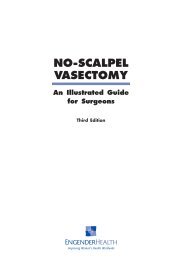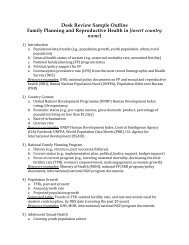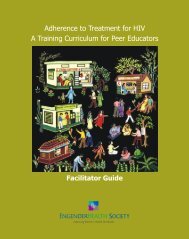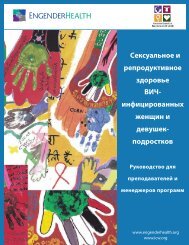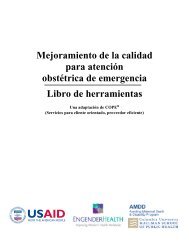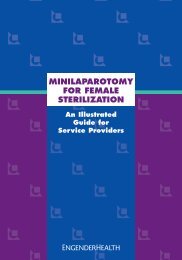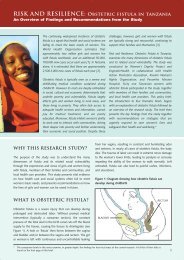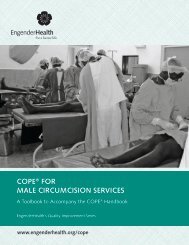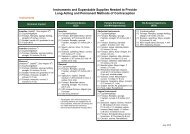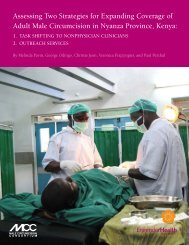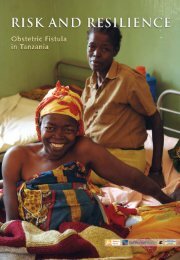Help-Seeking Pathways and Barriers for ... - EngenderHealth
Help-Seeking Pathways and Barriers for ... - EngenderHealth
Help-Seeking Pathways and Barriers for ... - EngenderHealth
Create successful ePaper yourself
Turn your PDF publications into a flip-book with our unique Google optimized e-Paper software.
1. Typical Patterns of <strong>Help</strong>-<strong>Seeking</strong><br />
Study findings are consistent with TDHS data that indicate the low prevalence of helpseeking<br />
among survivors of GBV in Tanzania. While the reasons <strong>for</strong> the gap are varied<br />
(<strong>Barriers</strong> to <strong>Help</strong>-<strong>Seeking</strong> are discussed in detail in Part III Section D below), the following<br />
quotation reflects the extent <strong>and</strong> cultural relevance of the issue:<br />
You know, what kills the society is the issue of secrecy. An individual can be abused yet<br />
keeps silent, can be beaten yet keeps silent, can be harassed yet keeps silent…To a<br />
woman who is married…a real wife has to keep quiet…others are afraid that, “If I speak,<br />
how will people see me, how will the society see me” You know the problem is, <strong>and</strong> I<br />
would like to share it with you, the problem is that there is a concept of shame upon the<br />
victim, <strong>and</strong> not shame upon the perpetrator. There is a need of changing the society.<br />
Service provider, Mbeya<br />
<strong>Pathways</strong> begin with the family<br />
Given the context of infrequent help-seeking, it is not surprising that across the PFG maps<br />
the initial step is almost always an in<strong>for</strong>mal source of support, most often the family or<br />
another member of the survivor’s close social network. A map created by a women’s PFG in<br />
Iringa is consistent with the common pathway presented by many of the groups (see<br />
Figure 2 below). The survivor of domestic violence, named Jua <strong>for</strong> the exercise, initially<br />
goes to her parents where she is sent back to her in-laws, <strong>and</strong> subsequently to a family<br />
meeting. When the violence continues, Jua tires of this routine <strong>and</strong> goes to the police. From<br />
the police, she may be sent back to the family <strong>for</strong> another attempt at reconciliation, or, “if<br />
she is hurt,” Jua may go to the hospital. The map depicts a loop between the hospital <strong>and</strong><br />
the police to signify that she may need to navigate between these two channels in order to<br />
obtain, complete, <strong>and</strong> finally submit a PF3. From there, the pathway suggests that Jua can<br />
again return home, or perhaps seek help from a local FBO. Annotations on the diagram<br />
explain that the FBO is where the husb<strong>and</strong> “admits he is wrong” <strong>and</strong> Jua “<strong>for</strong>gives him.”<br />
Despite the different options depicted on the map, the family is dominant <strong>and</strong> all routes<br />
eventually lead back to the marital home.<br />
Notably the map does not show a court of law, or present divorce as an option <strong>for</strong> Jua.<br />
When included, courts are consistently presented as a final pathway, when all other options<br />
have been exhausted <strong>and</strong> the survivor has persevered against significant obstacles.<br />
<strong>Help</strong>-<strong>Seeking</strong> <strong>Pathways</strong> <strong>and</strong> <strong>Barriers</strong> <strong>for</strong> Survivors of GBV in Tanzania March 2013<br />
Page 32



